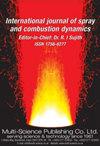湍流环形燃烧器向方位角不稳定性的间歇过渡
IF 2.1
4区 工程技术
Q3 ENGINEERING, MECHANICAL
International Journal of Spray and Combustion Dynamics
Pub Date : 2024-08-28
DOI:10.1177/17568277241276495
引用次数: 0
摘要
我们通过实验研究了实验室规模的湍流环形燃烧器从燃烧噪声状态向方位热声不稳定性状态的转变。该燃烧器有十六个漩涡稳定燃烧器,以促进沿环形区域连续和空间分布的燃烧。我们的方法包括使用两台高速摄像机同时测量火焰的 CH* 化学发光发射,以及使用安装在燃烧器背板上的八个压电压力传感器同时测量声压波动。我们观察到,从燃烧噪声到方位角不稳定性的转变是通过模式转换实现的,即随着等效比的降低,系统从纵向模式转换为方位角模式。在整个过程中,燃烧器表现出各种动力学行为,包括间歇性、双模不稳定性、驻留方位角不稳定性和跳动方位角不稳定性。通过将声压波动分解为顺时针(CW)波和逆时针(CCW)波,从获取的压力信号中确定这些动力学状态,从而能够重建声压波动的振幅、性质角、(反)节点线位置和自旋比。然后,通过对声压周期内的热释放率波动进行相平均,研究了各种动力学状态下的全局热释放响应,对比了它们在不同非维度时间步长下的行为。根据压力波的传播方向,我们观察到了不同的火焰行为,展示了特征性的 CCW 旋转、静止和 CW 旋转热释放模式。此外,我们还通过分析所有燃烧器相对于一个燃烧器的热释放率波动相位,对各种动力学状态下的相对相位分布进行了研究,结果表明,受声场影响,相邻火焰之间的相互作用出现了多种模式。本文章由计算机程序翻译,如有差异,请以英文原文为准。
Intermittency transition to azimuthal instability in a turbulent annular combustor
We experimentally study the transition from a state of combustion noise to azimuthal thermoacoustic instability in a laboratory-scale turbulent annular combustor. This combustor has sixteen swirl-stabilized burners to facilitate continuous and spatially distributed combustion along the annular region. Our approach involves simultaneous measurement of CH* chemiluminescence emission of the flame using two high-speed cameras and the acoustic pressure fluctuations using eight piezoelectric pressure transducers mounted on the backplane of combustor. We observe that the transition from combustion noise to azimuthal instability occurs through mode shifting, where the system switches from a longitudinal mode to an azimuthal mode as the equivalence ratio is decreased. Throughout this progression, the combustor exhibits various dynamical behaviors, including intermittency, dual-mode instability, standing azimuthal instability, and beating azimuthal instability. These dynamical states are determined from the acquired pressure signals by decomposing the acoustic pressure fluctuations into clockwise (CW) and counterclockwise (CCW) waves, enabling a reconstruction of the amplitude of acoustic pressure fluctuations, nature angle, (anti-)nodal line location, and spin ratio. The global heat release response is then examined during various dynamical states, contrasting their behavior at different non-dimensional time steps by phase-averaging the fluctuations of the heat release rate over the acoustic pressure cycle. Distinctive flame behaviors were observed based on the direction of pressure wave propagation, showcasing characteristic CCW spinning, standing, and CW spinning heat release patterns. Moreover, our examination of relative phase distributions during various dynamical states, computed by analyzing the phase of heat release rate fluctuations across all burners with respect to one burner, reveals the emergence of diverse patterns in the interaction of neighboring flames influenced by acoustic field.
求助全文
通过发布文献求助,成功后即可免费获取论文全文。
去求助
来源期刊

International Journal of Spray and Combustion Dynamics
THERMODYNAMICS-ENGINEERING, MECHANICAL
CiteScore
2.20
自引率
12.50%
发文量
21
审稿时长
>12 weeks
期刊介绍:
International Journal of Spray and Combustion Dynamics is a peer-reviewed open access journal on fundamental and applied research in combustion and spray dynamics. Fundamental topics include advances in understanding unsteady combustion, combustion instability and noise, flame-acoustic interaction and its active and passive control, duct acoustics...
 求助内容:
求助内容: 应助结果提醒方式:
应助结果提醒方式:


